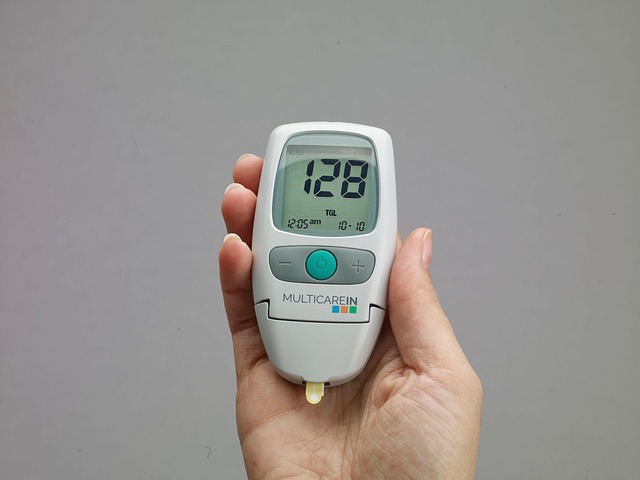Semaglutide is a groundbreaking medication that revolutionizes diabetes prevention and management, particularly for type 2 diabetes. By mimicking the natural hormone GLP-1, it improves glycemic control through multiple aspects of glucose metabolism, including stimulating insulin secretion, suppressing glucagon release, and promoting weight loss. Clinical trials have shown its effectiveness in preventing type 2 diabetes, especially in pre-diabetic individuals. Semaglutide's dual action mechanism offers better blood sugar control with fewer hypoglycemic episodes and reduces cardiovascular risks compared to traditional treatments. Its once-weekly administration and holistic approach make it a promising alternative for managing metabolic health, including obesity-related disorders, and improving overall patient well-being.
Semaglutide, a novel glucose-lowering drug, is emerging as a powerful tool in diabetes prevention. This review delves into the multi-faceted role of semaglutide in metabolic regulation, focusing on its efficacy in pre-diabetes and safety profile. By exploring clinical trials and understanding the mechanisms behind its blood sugar control, we uncover the potential of semaglutide to revolutionize diabetes management, offering a promising alternative to traditional treatments.
Understanding Semaglutide: A Novel Diabetes Prevention Approach

Semaglutide is a groundbreaking medication that has emerged as a promising tool in the prevention and management of diabetes, particularly type 2 diabetes. This novel approach to diabetes treatment mimics the actions of a natural hormone called GLP-1 (glucagon-like peptide-1), which plays a crucial role in regulating blood sugar levels. By activating specific receptors in the body, semaglutide stimulates insulin secretion and suppresses glucagon release, leading to improved glycemic control.
The unique mechanism of action sets semaglutide apart from traditional diabetes medications. Unlike other drugs that primarily focus on reducing blood sugar, semaglutide takes a holistic approach by influencing multiple aspects of glucose metabolism. Clinical trials have demonstrated its efficacy in lowering HbA1c (a marker of long-term blood sugar control) and promoting weight loss, making it an attractive option for individuals at risk of developing type 2 diabetes or those struggling with weight management.
The Role of Semaglutide in Metabolic Regulation

Semaglutide, a novel drug with remarkable properties, is emerging as a powerful tool in the prevention and management of diabetes. Its primary role lies in its ability to mimic natural hormones that regulate metabolism. By activating certain receptors in the brain, semaglutide stimulates feelings of fullness and reduces appetite, leading to decreased calorie intake. This effect is particularly beneficial for individuals at risk of developing type 2 diabetes, as it can help prevent weight gain and improve insulin sensitivity.
In addition to its appetite-reducing effects, semaglutide also plays a crucial role in glucose metabolism. It enhances the release of insulin in a glucose-dependent manner, ensuring that blood sugar levels are tightly controlled. Furthermore, semaglutide inhibits the activity of glucagon, a hormone that raises blood sugar. This dual action significantly improves glycemic control, making it an effective diabetes treatment and potential game-changer in metabolic regulation.
Clinical Trials: Exploring Semaglutide's Efficacy in Pre-diabetes

Clinical trials have played a pivotal role in unraveling the potential of semaglutide as a powerful tool in diabetes prevention, especially for those with pre-diabetes. These studies have shown promising results, highlighting semaglutide’s ability to significantly reduce the risk of type 2 diabetes in individuals with prediabetic conditions. By mimicking the effects of natural human hormones, semaglutide has demonstrated its efficacy in lowering blood sugar levels and improving overall metabolic health.
The ongoing exploration focuses on understanding the long-term benefits and optimal dosing strategies. Researchers are meticulously evaluating how semaglutide influences not just glucose control but also other diabetes-related complications. This targeted approach aims to refine treatment protocols, ensuring that semaglutide is utilized effectively as a preventive measure for diabetes, thereby offering hope for improved management and reduced burden of this chronic disease.
Mechanisms Behind Semaglutide's Blood Sugar Control

Semaglutide, a novel glucagon-like peptide-1 (GLP-1) receptor agonist, has emerged as a powerful tool in diabetes prevention and management. Its mechanism of action is multifaceted, primarily involving the stimulation of insulin secretion in a glucose-dependent manner, which helps lower blood sugar levels. This process is particularly beneficial for prediabetic individuals, as it can prevent or delay the progression to type 2 diabetes.
Additionally, semaglutide suppresses glucagon release, reducing excessive liver glucose production. This dual action, coupled with its ability to enhance insulin sensitivity and slow gastric emptying, makes it an effective diabetes treatment option. Research indicates that these mechanisms contribute to improved glycemic control, making semaglutide a game-changer in the realm of diabetes prevention and a promising avenue for future treatments.
Safety and Side Effects: What Research Reveals

Emerging research highlights that semaglutide, a medication initially developed for diabetes treatment, has shown promise in diabetes prevention. Clinical trials have consistently demonstrated its efficacy in reducing glycemic levels and improving metabolic health markers. However, as with any pharmaceutical intervention, understanding safety profiles is paramount. Studies indicate that semaglutide generally exhibits a favorable safety profile. Common side effects include gastrointestinal issues such as nausea, vomiting, and diarrhea, which are typically mild to moderate and often resolve over time. More serious adverse events are rare but can include pancreatitis and renal problems.
A key aspect of semaglutide’s safety is its mechanism of action targeting the glucagon-like peptide-1 (GLP-1) receptor. This targeted approach may contribute to a lower incidence of hypoglycemia compared to other diabetes treatments. Longitudinal studies continue to monitor both short-term and long-term safety, providing valuable insights for healthcare professionals and individuals at risk of developing type 2 diabetes.
Comparing Semaglutide to Traditional Diabetes Treatments

Semaglutide, a novel glucose-lowering medication, offers a promising alternative to traditional diabetes treatments. Unlike insulin injections or oral hypoglycemic agents that primarily focus on managing blood sugar levels, semaglutide targets multiple aspects of metabolic health. It mimics the effects of the gut hormone GLP-1, stimulating insulin secretion in a glucose-dependent manner and suppressing glucagon release. This dual action not only improves glycemic control but also promotes weight loss—a significant advantage for preventing type 2 diabetes, especially considering obesity is a key risk factor.
Compared to conventional treatments, semaglutide demonstrates several advantages. It provides better blood sugar control with fewer hypoglycemic episodes and has been shown to reduce the risk of cardiovascular events. Moreover, its once-weekly administration makes it more convenient than daily injections or frequent tablet intake. These factors contribute to improved patient adherence and quality of life, making semaglutide a potential game-changer in diabetes prevention and management.
Future Prospects: Expanding Semaglutide's Application in Diabetes Management

Future prospects for semaglutide in diabetes management look promising, with ongoing and expanding research exploring its potential beyond type 2 diabetes prevention. Semaglutide’s effectiveness as a monotherapy or in combination with other drugs is being investigated, offering the possibility of personalized treatment plans. The drug’s ability to lower not only blood sugar levels but also contribute to weight loss makes it an attractive option for managing obesity-related metabolic disorders.
Additionally, studies are delving into semaglutide’s role in improving cardiovascular health, a significant concern for diabetics. By targeting multiple aspects of diabetes management, researchers aim to enhance overall patient well-being and potentially reduce long-term complications associated with the condition. As semaglutide continues to gain traction as a versatile diabetes treatment, it may soon become an integral part of comprehensive diabetes care strategies.
